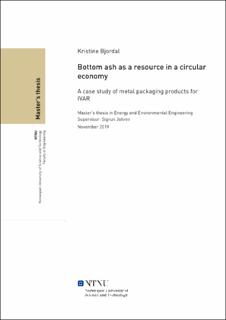Bottom ash as a resource in a circular economy - A case study of metal packaging products for IVAR
| dc.contributor.advisor | Jahren, Sigrun | |
| dc.contributor.author | Bjordal, Kristine | |
| dc.date.accessioned | 2021-11-19T11:51:00Z | |
| dc.date.available | 2021-11-19T11:51:00Z | |
| dc.date.issued | 2019 | |
| dc.identifier.uri | https://hdl.handle.net/11250/2830471 | |
| dc.description.abstract | Today, the residual waste from households is sent to waste-to-energy plants, and one of the bi-products created is incineration bottom ash. This is an inhomogeneous material which undergoes minimal final treatment, and IVAR wanted to investigate this fraction regarding a circular economy. They wanted to investigate how the metal packaging products behave through their incineration plant at Forus Energi, and estimate the fractions which are recovered and those that are potentially lost to landfill. The overall objective of this thesis is to evaluate incineration bottom ash as a resource in a circular economy perspective with focus on metal packaging products and the mineral fraction. A case study was developed and a material flow analysis approach is used to track the metal packaging products through the existing WtE plant and bottom ash treatment. Themodel investigated the goods layer, metal packaging layer, ferrous metal packaging products, non-ferrous metal packaging products, and the product group food cans. To obtain the necessary information for the case study a picking analyses was conducted at the WtE plant. Further, four future scenarios for the year 2030were modelled with new bottomash treatment technologies to investigate the improvement potential regarding the recycling rate. The model showed that in the current system 83% of the metal packaging products are recovered from the bottom ash and 17% is lost to the mineral fraction. In the future scenarios with extended bottom ash technologies, the recycling rate was increased to 98¡100%. In the literature review it was found that the bottom ash mineral fraction can be recycled and used as a construction material or as an adsorbent in stormwater treatment. However, there are some limitations in the Norwegian legislations, and Norway should look to other countries regarding how bottomash can be a resource in a circular economy. | en_US |
| dc.description.abstract | I dag blir restavfallet fra husholdninger sendt til forbrenningsanlegg og et biprodukt fra denne prosessen er bunnaske. Dette er et inhomogent materiale som i liten grad etterbehandles. IVAR ønsker å undersøke hvordan denne fraksjonen kan inngå i en sirkulær økonomi ved å undersøke hvordan metallemballasje-produkter oppfører seg gjennom forbrenningsanlegget til Forus Energi. Samt å estimere andelen sendt til resirkulering og andelen som går tapt til mineralfraksjonen som ender i deponi. Målet for denne masteroppgaven er å undersøke bunnasken som en ressurs i en sirkulær økonomi med fokus på metallemballasjeprodukter og mineralandelen i bunnasken. En "case study" har blitt utviklet der materialstrømanalyse er brukt for å følge metallemballasjeproduktene gjennom forbrenningen og bunnaskebehandlingen. Modellen undersøker massestrømmene til restavfallet, metallemballasjeproduktene, magnetiske emballasjeprodukter og ikke-magnetiske emballasjeprodukter, og til slutt en produktgruppe av hermetikkbokser. For å innhente nødvendig informasjon til modellen ble det gjennomført en plukkanalyse på forbrenningsanlegget. Det ble så utviklet fire framtidsscenarioer for året 2030 med ny behandlingsteknologi for bunnaske for å undersøke forbedringspotensialet til resirkuleringsgraden. Resultat fra studien viste at ved nåværende system gjenvinnes 83% av metallemballasje-produktene fra bunnasken og 17% går tapt til deponi. I framtidsscenarioene økte resirkuleringsandelen til 98¡100%. I litteraturstudien ble det funnet ut at mineralfraksjonen til bunnasken kunne bli brukt som konstruksjonsmateriale eller som adsorbent i overvannsbehandling. En begrensing knyttet til bruken av bunnasken er Norges strenge regelverk, og det anbefales derfor at Norge bør se til andre land for hvordan bunnaske kan brukes som ressurs i en sirkulær økonomi. | en_US |
| dc.language.iso | eng | en_US |
| dc.publisher | NTNU | en_US |
| dc.title | Bottom ash as a resource in a circular economy - A case study of metal packaging products for IVAR | en_US |
| dc.type | Master thesis | en_US |
